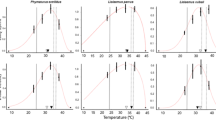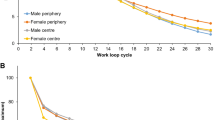Abstract
The importance of studying individual variation in locomotor performance has long been recognized as it may determine the ability of an organism to escape from predators, catch prey or disperse. In ectotherms, locomotor performance is highly influenced by ambient temperature (T a), yet several studies have showed that individual differences are usually retained across a T a gradient. Less is known, however, about individual differences in thermal sensitivity of performance, despite the fact that it could represent adaptive sources of phenotypic variation and/or additional substrate for selection to act upon. We quantified swimming and jumping performance in 18 wild-caught tropical clawed frogs (Xenopus tropicalis) across a T a gradient. Maximum swimming velocity and acceleration were not repeatable and individuals did not differ in how their swimming performance varied across T a. By contrast, time and distance jumped until exhaustion were repeatable across the T a gradient, indicating that individuals that perform best at a given T a also perform best at another T a. Moreover, thermal sensitivity of jumping endurance significantly differed among individuals, with individuals of high performance at low T a displaying the highest sensitivity to T a. Individual differences in terrestrial performance increased with decreasing T a, which is opposite to results obtained in lizards at the inter-specific and among-individual levels. To verify the generality of these patterns, we need more studies on individual variation in thermal reaction norms for locomotor performance in lizards and frogs.




Similar content being viewed by others
References
Angilletta MJ Jr, Niewiarowski PH, Navas CA (2002) The evolution of thermal physiology in ectotherms. J Therm Biol 27:249–268
Angilletta MJ Jr, Wilson RS, Navas CA, James RS (2003) Tradeoffs and the evolution of thermal reaction norms. Trends Ecol Evol 18:234–240
Arnold SJ (1983) Morphology, performance and fitness. Am Zool 23:347–361
Arnold SJ, Bennett AF (1984) Behavioral variation in natural populations. III. Antipredator displays in the garter snake Thamnophis radix. Anim Behav 32:1108–1118
Artacho P, Jouanneau I, Le Galliard J-F (2013) Interindividual variation in thermal sensitivity of maximal sprint speed, thermal behavior, and resting metabolic rate in a lizard. Physiol Biochem Zool 86:458–469
Baumann H, Conover DO (2011) Adaptation to climate change: contrasting patterns of thermal-reaction-norm evolution in Pacific vs Atlantic silversides. Proc R Soc Lond Ser B Biol Sci 278:2265–2273
Bennett AF (1980) The thermal dependence of lizard behavior. Anim Behav 28:752–762
Boake CR (1989) Repeatability: its role in evolutionary studies of mating behavior. Evol Ecol 3:173–182
Braña F (2003) Morphological correlates of burst speed and field movement patterns: the behavioural adjustment of locomotion in wall lizards (Podarcis muralis). Biol J Linn Soc 80:135–146
Brodie ED III, Russell NH (1999) The consistency of individual differences in behaviour: temperature effects on antipredator behaviour in garter snakes. Anim Behav 57:445–451
Brommer JE (2013) Phenotypic plasticity of labile traits in the wild. Curr Zool 59:485–505
Butler D, Cullis BR, Gilmour AR, Gogel DJ (2009) ASReml-R reference manual Release 3.0 (draft copy). VSN, Hemel Hempstead
Careau V, Garland T Jr (2012) Performance, personality, and energetics: correlation, causation, and mechanism. Physiol Biochem Zool 85:543–571
Careau V, Gifford ME, Biro PA (2014) Individual (co)variation in thermal reaction norms of standard and maximal metabolic rates in wild-caught slimy salamanders. Funct Ecol. doi:10.1111/1365-2435.12259
Casterlin ME, Reynolds WW (1980) Diel activity and thermoregulatory behavior of a fully aquatic frog: Xenopus laevis. Hydrobiologia 75:189–191
Conover DO, Duffy TA, Hice LA (2009) The covariance between genetic and environmental influences across ecological gradients reassessing the evolutionary significance of countergradient and cogradient variation. Ann NY Acad Sci 1168:100–129
Djawdan M, Garland T Jr (1988) Maximal running speeds of bipedal and quadrupedal rodents. J Mammal 69:765–772
Dominicus A, Skrondal A, Gjessing HK, Pedersen NL, Palmgren J (2006) Likelihood ratio tests in behavioral genetics: problems and solutions. Behav Genet 36:331–340
Elnitsky MA, Claussen DL (2006) The effects of temperature and inter-individual variation on the locomotor performance of juvenile turtles. J Comp Physiol B 176:497–504
Friedman WA, Garland T Jr, Dohm MR (1992) Individual variation in locomotor behavior and maximal oxygen consumption in mice. Physiol Behav 52:97–104
Garland T Jr (1988) Genetic basis of activity metabolism. I. Inheritance of speed, stamina, and antipredator displays in the garter snake Thamnophis sirtalis. Evolution 42:335–350
Garland T Jr, Losos JB (1994) Ecological morphology of locomotor performance in squamate reptiles. In: Wainwright PC, Reilly SM (eds) Ecological morphology: integrative organismal biology. University of Chicago Press, Chicago, pp 240–302
Gilchrist GW (1996) A quantitative genetic analysis of thermal sensitivity in the locomotor performance curve of Aphidius ervi. Evolution 50:1560–1572
Hadfield JD, Nakagawa S (2010) General quantitative genetic methods for comparative biology: phylogenies, taxonomies and multi-trait models for continuous and categorical characters. J Evol Biol 23:494–508
Henderson CR (1982) Analysis of covariance in the mixed model—higher-level, non-homogeneous, and random regressions. Biometrics 38:623–640
Herrel A, Bonneaud C (2012) Temperature dependence of locomotor performance in the tropical clawed frog, Xenopus tropicalis. J Exp Biol 215:2465–2470
Herrel A, Gonwouo LN, Fokam EB, Ngundu WI, Bonneaud C (2012) Intersexual differences in body shape and locomotor performance in the aquatic frog, Xenopus tropicalis. J Zool 287:311–316
Huey RB, Dunham AE (1987) Repeatability of locomotor performance in natural populations of the lizard Sceloporus merriami. Evolution 41:1116–1120
Huey RB, Hertz PE (1984) Is a jack-of-all-temperatures a master of none? Evolution 38:441–444
Huey RB, Stevenson RD (1979) Integrating thermal physiology and ecology of ectotherms: discussion of approaches. Am Zool 19:357–366
Husak JF (2006) Does survival depend on how fast you can run or how fast you do run? Funct Ecol 20:1080–1086
Husak JF, Fox SF (2006) Field use of maximal sprint speed by collared lizards (Crotaphytus collaris): compensation and sexual selection. Evolution 60:1888–1895
Irschick DJ (2003) Measuring performance in nature: implications for studies of fitness within populations. Integr Comp Biol 43:396–407
Irschick DJ, Garland T Jr (2001) Integrating function and ecology in studies of adaptation: investigations of locomotor capacity as a model system. Annu Rev Ecol Syst 32:367–396
Irschick DJ, Herrel AV, Vanhooydonck B, Huyghe K, Van Damme R (2005) Locomotor compensation creates a mismatch between laboratory and field estimates of escape speed in lizards: a cautionary tale for performance-to-fitness studies. Evolution 59:1579–1587
Izem R, Kingsolver JG (2005) Variation in continuous reaction norms: quantifying directions of biological interest. Am Nat 166:277–289
John-Alder HB, Morin PJ, Lawler S (1988) Thermal physiology, phenology, and distribution of tree frogs. Am Nat 132:506–520
Kenward MG, Roger JH (1997) The precision of fixed effects estimates from restricted maximum likelihood. Biometrics 53:983–997
Knies JL, Kingsolver JG, Burch CL (2009) Hotter is better and broader: thermal sensitivity of fitness in a opulation of bacteriophages. Am Nat 173:419–430
Knowles TW, Weigl PD (1990) Thermal dependence of anuran burst locomotor performance. Copeia 1990:796–802
Latimer CAL, Wilson RS, Chenoweth SF (2011) Quantitative genetic variation for thermal performance curves within and among natural populations of Drosophila serrata. J Evol Biol 24:965–975
Londos PL, Brooks RJ (1988) Effect of temperature acclimation on locomotory performance curves in the toad, Bufo woodhousii woodhousii. Copeia 1:26–32
Lynch M, Walsh JB (1998) Genetics and analysis of quantitative traits. Sinauer, Sunderland
Martin JGA, Nussey DH, Wilson AJ, Réale D (2011) Measuring individual differences in reaction norms in field and experimental studies: a power analysis of random regression models. Methods Ecol Evol 2:362–374
Miller K (1982) Effect of temperature on sprint performance in the frog Xenopus laevis and the salamander Necturus maculosus. Copeia 3:695–698
Nakagawa S, Schielzeth H (2013) A general and simple method for obtaining R 2 from generalized linear mixed-effects models. Methods Ecol Evol 4:133–142
Navas CA, Gomes FR, Carvalho JE (2008) Thermal relationships and exercise physiology in anuran amphibians: integration and evolutionary implications. Comp Biochem Physiol A 151:344–362
Niehaus AC, Wilson RS, Seebacher F, Franklin CE (2011) Striped marsh frog (Limnodynastes peronii) tadpoles do not acclimate metabolic performance to thermal variability. J Exp Biol 214:1965–1970
Preest MR, Pough FH (1989) Interaction of temperature and hydration on locomotion of toads. Funct Ecol 3:693–699
Putnam RW, Bennett AF (1981) Thermal dependence of behavioural performance of anuran amphibians. Anim Behav 29:502–509
Rödel MO (2000) Herpetofauna of West Africa. Chimaira, Frankfurt am Main
Šamajová P, Gvoždík L (2010) Inaccurate or disparate temperature cues? Seasonal acclimation of terrestrial and aquatic locomotor capacity in newts. Funct Ecol 24:1023–1030
Singer JD, Willett JB (2003) Applied longitudinal data analysis: modeling change and event occurrence. Oxford University Press, New York
Stinchcombe JR, Function-valued_Traits_Working_Group, Kirkpatrick M (2012) Genetics and evolution of function-valued traits: understanding environmentally responsive phenotypes. Trends Ecol Evol 27:637–647
Van Berkum FH, Huey RB, Tsuji JS, Garland T Jr (1989) Repeatability of individual differences in locomotor performance and body size during early ontogeny of the lizard Sceloporus occidentalis (Baird & Girard). Funct Ecol 3:97–105
Walton M (1988) Relationships among metabolic, locomotory, and field measures of organismal performance in the Fowler’s toad (Bufo woodhousei fowleri). Physiol Zool 61:107–118
Whitehead PJ, Puckridge JT, Leigh CM, Seymour RS (1989) Effect of temperature on jump performance of the frog Limnodynastes tasmaniensis. Physiol Zool 62:937–949
Wilson RS (2001) Geographic variation in thermal sensitivity of jumping performance in the frog Limnodynastes peronii. J Exp Biol 204:4227–4236
Wilson RS, James RS, Johnston IA (2000) Thermal acclimation of locomotor performance in tadpoles and adults of the aquatic frog Xenopus laevis. J Comp Physiol B 170:117–124
Winter D (2004) Biomechanics and motor control of human movement. Wiley, New York
Acknowledgments
We would like to thank L. N. Gonwouo for his valuable help in the field, J. Rodriguez for help with animal husbandry, and M. Antoine for logistical support. This research was supported by the Agence Nationale de la Recherche MOBIGEN (ANR-09-PEXT-003 to A. H. and C. B.), a Muséum National d’Histoire Naturelle Action transversale du Muséum (ATM) grant of the Biodiversité actuelle et fossile programme to A. H., a Marie Curie reintegration grant to C. B. (FP7-PEOPLE-IRG-2008 no. 239257), an Alfred Deakin postdoctoral research fellowship to V. C., and an ARC Future Fellowship to P. A. B. We thank two anonymous reviewers for their constructive comments on a previous draft.
Author information
Authors and Affiliations
Corresponding author
Additional information
Communicated by Jean-François Le Galliard.
Electronic supplementary material
Below is the link to the electronic supplementary material.
Rights and permissions
About this article
Cite this article
Careau, V., Biro, P.A., Bonneaud, C. et al. Individual variation in thermal performance curves: swimming burst speed and jumping endurance in wild-caught tropical clawed frogs. Oecologia 175, 471–480 (2014). https://doi.org/10.1007/s00442-014-2925-7
Received:
Accepted:
Published:
Issue Date:
DOI: https://doi.org/10.1007/s00442-014-2925-7




